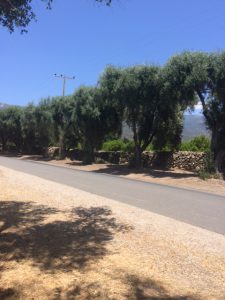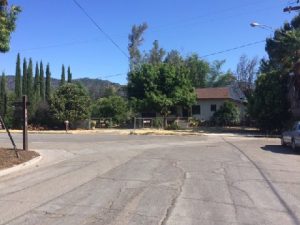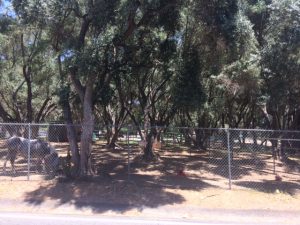The following article was written by Howard Bald and appeared in the July 18, 1973 edition of the Ojai Valley News. It is reprinted here with their permission. Photos have been added by the Ojai Valley Museum. Bald titled his many articles with the same title. So, this article has “(No. 1)” added by the Ojai Valley Museum.
Reminiscences of Early Ojai (No. 1)
by
Howard Bald
I have mentioned citrus and haying of the early 1900’s, but there were some agricultural ventures that were short-lived. One was olive growing.
It must have been in the late 1880’s that several hundred acres were planted to olives, mostly in the northeast end of the valley, for there are still some magnificent large olive trees north of Grand Avenue near its west end and along McNell road.

I have been told by Phillip Pierpont that the fruit at that time was mostly cured in barrels for eating, but no one knew much about the curing process as we know it today. Many were experimenting with their own methods. Pierpont said for oil some even put the fruit through a meat grinder, then pressed the oil out.
In most cases for eating out of hand the fruit spoiled in attempts to cure. Phil tells of his father giving his fruit to a man to be cured on shares. Later his father was told that his share spoiled, so Dr. Pierpont got nothing.
In about 1901 some growers formed an association and built on olive mill near the Southern Pacific depot at the south end of what is now Bald street. My father helped put up that building and install the machinery. Then he operated the mill. In fact he was the only one who ever did operate it. I think it operated for less than two years.

Dad not only did the crushing and pressing of the fruit, but the filtering and bottling as well. The bottled olive oil was said to have been of a superior quality, and Mr. J.J. Burke went on the road as an agent. But because of the much cheaper imported Italian product, it was not a success, and the mill soon closed down. Some time later my father bought the mill and the property, consisting of some nine acres.
I will relate some of my recollections of that operation. Most of the time dad was the sole employee. Rather than shut the machinery down in the evening, he ran an around-the-clock shift. He had a cot and would take cat naps while the machinery ground on. It was run by a small gasoline engine. (Small, that is, as compared with the engines that operated the citrus growers pumps.)
Our home was on N. Signal street, and three times a day, rain or shine, I promptly delivered to him a hot meal.
When he turned in his time for a 24 hour-a-day shift (his pay was 25 cents an hour, or $6 a day), there was something of a stir among the directors. But when he proved that it was more economical to keep the machinery running (he was the only one qualified to operate it), Mr. Edward Thacher, the association president, ruled in his favor.
A few of the more ambitious youngsters, my sister included, would pick olives on Saturdays and during the Christmas holidays. We received 35 cents for picking a 60 pound lug. Once I had $1.05 coming for picking three lugs, but my employer insisted that the boxes were not full enough, and therefore $1 was all that was due me. He later became one of Ojai’s wealthiest and most respected citizens.

During one Christmas vacation I sorted and sacked onions for a local farmer along with three men. I was probably 14 or 15, but I consistently sacked more onions than any of the three men, and my employer admitted as much. I knew they were receiving $2 per day for a ten hour day, but when it came to settling up, my employer would pay me only $1.50 per day, saying the men wouldn’t like it if he gave me a man’s pay.
Of course, I might have written it off by saying that members of my family and I had stolen enough watermelons to make up the difference. Years later I heard him jokingly remark that three generations of Clarks had stolen melons from him.
